TLAW 202 Corporations Law: Separate Legal Entity and Liability
VerifiedAdded on 2023/06/11
|7
|2523
|216
Report
AI Summary
This report addresses two legal scenarios under Australian Corporations Law. The first scenario involves Richard and his sons seeking advice on incorporating their olive grove business, focusing on the appropriate company name and the registration process under the Corporations Act 2001. It emphasizes the importance of selecting a distinct and non-misleading name and adhering to ASIC's registration requirements. The second scenario examines Terry's potential legal action against Lazarus Pty Ltd, CMS, and/or CM for injuries sustained due to polluted water from mining activities. It discusses the duty of care owed by companies to prevent harm to individuals, the concept of piercing the corporate veil in cases of fraudulent activities, and the potential liability of parent companies for the actions of their subsidiaries. The report applies relevant case law, such as Salomon v A Salomon and Co Ltd and Donoghue v Stevenson, to analyze the legal responsibilities and potential liabilities of the involved parties.
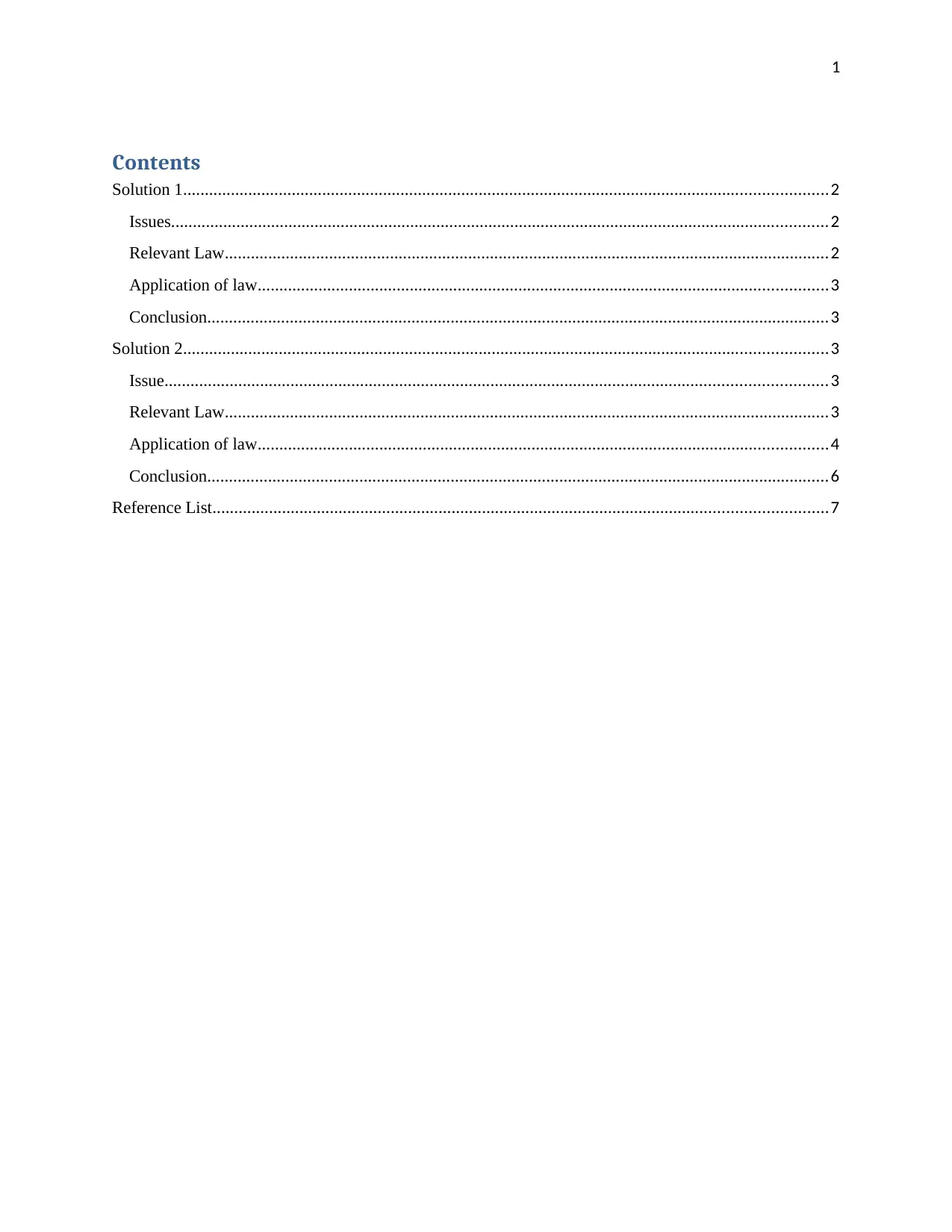
1
Contents
Solution 1....................................................................................................................................................2
Issues.......................................................................................................................................................2
Relevant Law...........................................................................................................................................2
Application of law...................................................................................................................................3
Conclusion...............................................................................................................................................3
Solution 2....................................................................................................................................................3
Issue........................................................................................................................................................3
Relevant Law...........................................................................................................................................3
Application of law...................................................................................................................................4
Conclusion...............................................................................................................................................6
Reference List.............................................................................................................................................7
Contents
Solution 1....................................................................................................................................................2
Issues.......................................................................................................................................................2
Relevant Law...........................................................................................................................................2
Application of law...................................................................................................................................3
Conclusion...............................................................................................................................................3
Solution 2....................................................................................................................................................3
Issue........................................................................................................................................................3
Relevant Law...........................................................................................................................................3
Application of law...................................................................................................................................4
Conclusion...............................................................................................................................................6
Reference List.............................................................................................................................................7
Paraphrase This Document
Need a fresh take? Get an instant paraphrase of this document with our AI Paraphraser
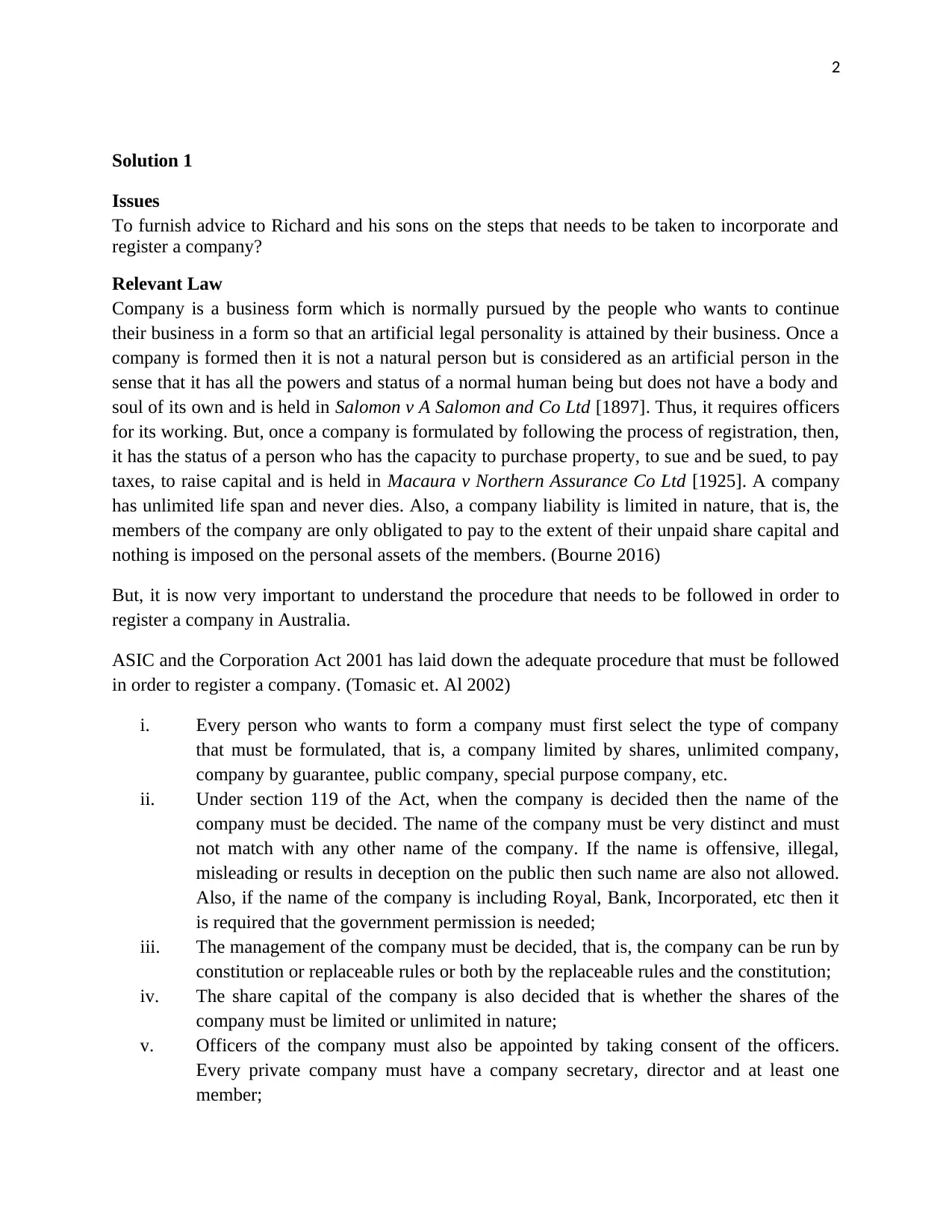
2
Solution 1
Issues
To furnish advice to Richard and his sons on the steps that needs to be taken to incorporate and
register a company?
Relevant Law
Company is a business form which is normally pursued by the people who wants to continue
their business in a form so that an artificial legal personality is attained by their business. Once a
company is formed then it is not a natural person but is considered as an artificial person in the
sense that it has all the powers and status of a normal human being but does not have a body and
soul of its own and is held in Salomon v A Salomon and Co Ltd [1897]. Thus, it requires officers
for its working. But, once a company is formulated by following the process of registration, then,
it has the status of a person who has the capacity to purchase property, to sue and be sued, to pay
taxes, to raise capital and is held in Macaura v Northern Assurance Co Ltd [1925]. A company
has unlimited life span and never dies. Also, a company liability is limited in nature, that is, the
members of the company are only obligated to pay to the extent of their unpaid share capital and
nothing is imposed on the personal assets of the members. (Bourne 2016)
But, it is now very important to understand the procedure that needs to be followed in order to
register a company in Australia.
ASIC and the Corporation Act 2001 has laid down the adequate procedure that must be followed
in order to register a company. (Tomasic et. Al 2002)
i. Every person who wants to form a company must first select the type of company
that must be formulated, that is, a company limited by shares, unlimited company,
company by guarantee, public company, special purpose company, etc.
ii. Under section 119 of the Act, when the company is decided then the name of the
company must be decided. The name of the company must be very distinct and must
not match with any other name of the company. If the name is offensive, illegal,
misleading or results in deception on the public then such name are also not allowed.
Also, if the name of the company is including Royal, Bank, Incorporated, etc then it
is required that the government permission is needed;
iii. The management of the company must be decided, that is, the company can be run by
constitution or replaceable rules or both by the replaceable rules and the constitution;
iv. The share capital of the company is also decided that is whether the shares of the
company must be limited or unlimited in nature;
v. Officers of the company must also be appointed by taking consent of the officers.
Every private company must have a company secretary, director and at least one
member;
Solution 1
Issues
To furnish advice to Richard and his sons on the steps that needs to be taken to incorporate and
register a company?
Relevant Law
Company is a business form which is normally pursued by the people who wants to continue
their business in a form so that an artificial legal personality is attained by their business. Once a
company is formed then it is not a natural person but is considered as an artificial person in the
sense that it has all the powers and status of a normal human being but does not have a body and
soul of its own and is held in Salomon v A Salomon and Co Ltd [1897]. Thus, it requires officers
for its working. But, once a company is formulated by following the process of registration, then,
it has the status of a person who has the capacity to purchase property, to sue and be sued, to pay
taxes, to raise capital and is held in Macaura v Northern Assurance Co Ltd [1925]. A company
has unlimited life span and never dies. Also, a company liability is limited in nature, that is, the
members of the company are only obligated to pay to the extent of their unpaid share capital and
nothing is imposed on the personal assets of the members. (Bourne 2016)
But, it is now very important to understand the procedure that needs to be followed in order to
register a company in Australia.
ASIC and the Corporation Act 2001 has laid down the adequate procedure that must be followed
in order to register a company. (Tomasic et. Al 2002)
i. Every person who wants to form a company must first select the type of company
that must be formulated, that is, a company limited by shares, unlimited company,
company by guarantee, public company, special purpose company, etc.
ii. Under section 119 of the Act, when the company is decided then the name of the
company must be decided. The name of the company must be very distinct and must
not match with any other name of the company. If the name is offensive, illegal,
misleading or results in deception on the public then such name are also not allowed.
Also, if the name of the company is including Royal, Bank, Incorporated, etc then it
is required that the government permission is needed;
iii. The management of the company must be decided, that is, the company can be run by
constitution or replaceable rules or both by the replaceable rules and the constitution;
iv. The share capital of the company is also decided that is whether the shares of the
company must be limited or unlimited in nature;
v. Officers of the company must also be appointed by taking consent of the officers.
Every private company must have a company secretary, director and at least one
member;
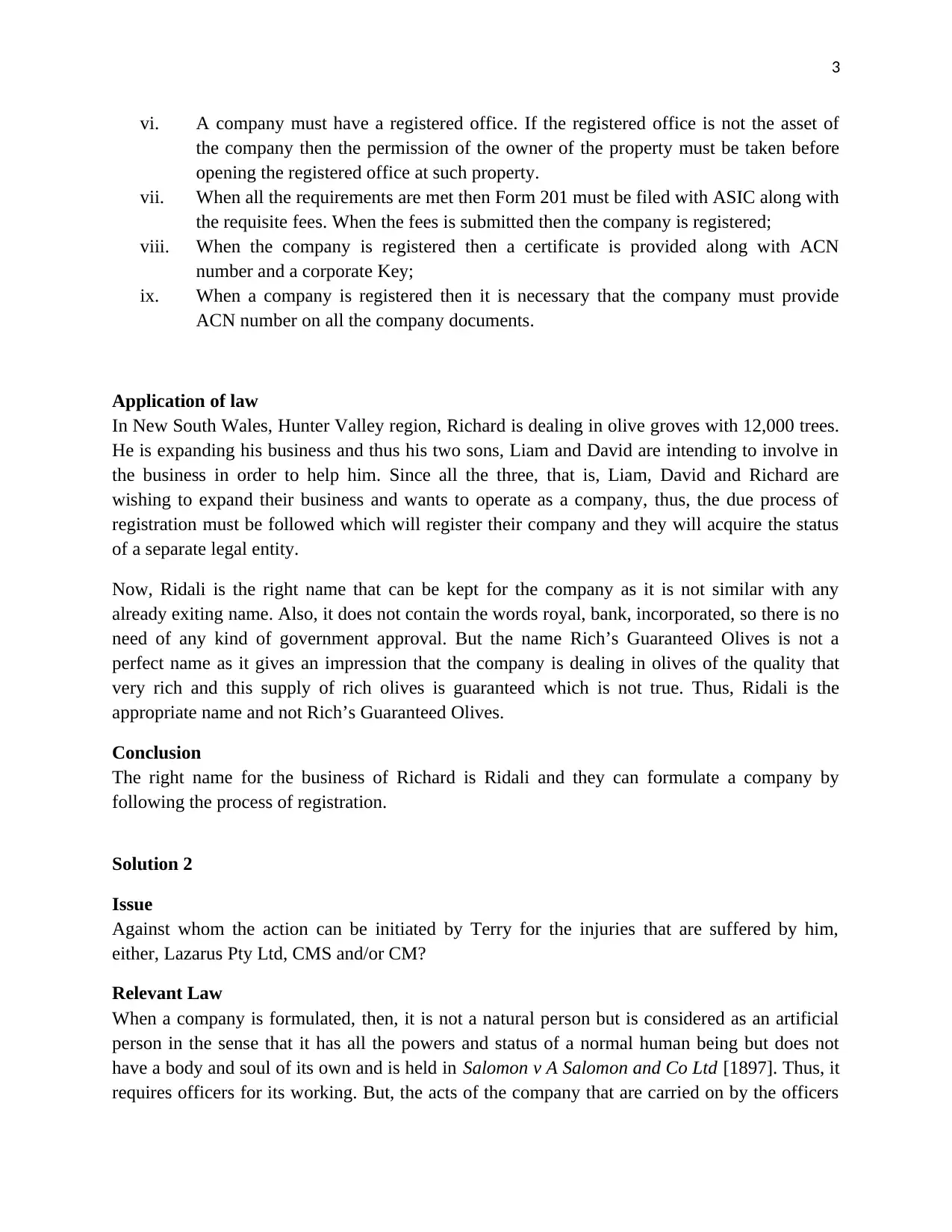
3
vi. A company must have a registered office. If the registered office is not the asset of
the company then the permission of the owner of the property must be taken before
opening the registered office at such property.
vii. When all the requirements are met then Form 201 must be filed with ASIC along with
the requisite fees. When the fees is submitted then the company is registered;
viii. When the company is registered then a certificate is provided along with ACN
number and a corporate Key;
ix. When a company is registered then it is necessary that the company must provide
ACN number on all the company documents.
Application of law
In New South Wales, Hunter Valley region, Richard is dealing in olive groves with 12,000 trees.
He is expanding his business and thus his two sons, Liam and David are intending to involve in
the business in order to help him. Since all the three, that is, Liam, David and Richard are
wishing to expand their business and wants to operate as a company, thus, the due process of
registration must be followed which will register their company and they will acquire the status
of a separate legal entity.
Now, Ridali is the right name that can be kept for the company as it is not similar with any
already exiting name. Also, it does not contain the words royal, bank, incorporated, so there is no
need of any kind of government approval. But the name Rich’s Guaranteed Olives is not a
perfect name as it gives an impression that the company is dealing in olives of the quality that
very rich and this supply of rich olives is guaranteed which is not true. Thus, Ridali is the
appropriate name and not Rich’s Guaranteed Olives.
Conclusion
The right name for the business of Richard is Ridali and they can formulate a company by
following the process of registration.
Solution 2
Issue
Against whom the action can be initiated by Terry for the injuries that are suffered by him,
either, Lazarus Pty Ltd, CMS and/or CM?
Relevant Law
When a company is formulated, then, it is not a natural person but is considered as an artificial
person in the sense that it has all the powers and status of a normal human being but does not
have a body and soul of its own and is held in Salomon v A Salomon and Co Ltd [1897]. Thus, it
requires officers for its working. But, the acts of the company that are carried on by the officers
vi. A company must have a registered office. If the registered office is not the asset of
the company then the permission of the owner of the property must be taken before
opening the registered office at such property.
vii. When all the requirements are met then Form 201 must be filed with ASIC along with
the requisite fees. When the fees is submitted then the company is registered;
viii. When the company is registered then a certificate is provided along with ACN
number and a corporate Key;
ix. When a company is registered then it is necessary that the company must provide
ACN number on all the company documents.
Application of law
In New South Wales, Hunter Valley region, Richard is dealing in olive groves with 12,000 trees.
He is expanding his business and thus his two sons, Liam and David are intending to involve in
the business in order to help him. Since all the three, that is, Liam, David and Richard are
wishing to expand their business and wants to operate as a company, thus, the due process of
registration must be followed which will register their company and they will acquire the status
of a separate legal entity.
Now, Ridali is the right name that can be kept for the company as it is not similar with any
already exiting name. Also, it does not contain the words royal, bank, incorporated, so there is no
need of any kind of government approval. But the name Rich’s Guaranteed Olives is not a
perfect name as it gives an impression that the company is dealing in olives of the quality that
very rich and this supply of rich olives is guaranteed which is not true. Thus, Ridali is the
appropriate name and not Rich’s Guaranteed Olives.
Conclusion
The right name for the business of Richard is Ridali and they can formulate a company by
following the process of registration.
Solution 2
Issue
Against whom the action can be initiated by Terry for the injuries that are suffered by him,
either, Lazarus Pty Ltd, CMS and/or CM?
Relevant Law
When a company is formulated, then, it is not a natural person but is considered as an artificial
person in the sense that it has all the powers and status of a normal human being but does not
have a body and soul of its own and is held in Salomon v A Salomon and Co Ltd [1897]. Thus, it
requires officers for its working. But, the acts of the company that are carried on by the officers
⊘ This is a preview!⊘
Do you want full access?
Subscribe today to unlock all pages.

Trusted by 1+ million students worldwide
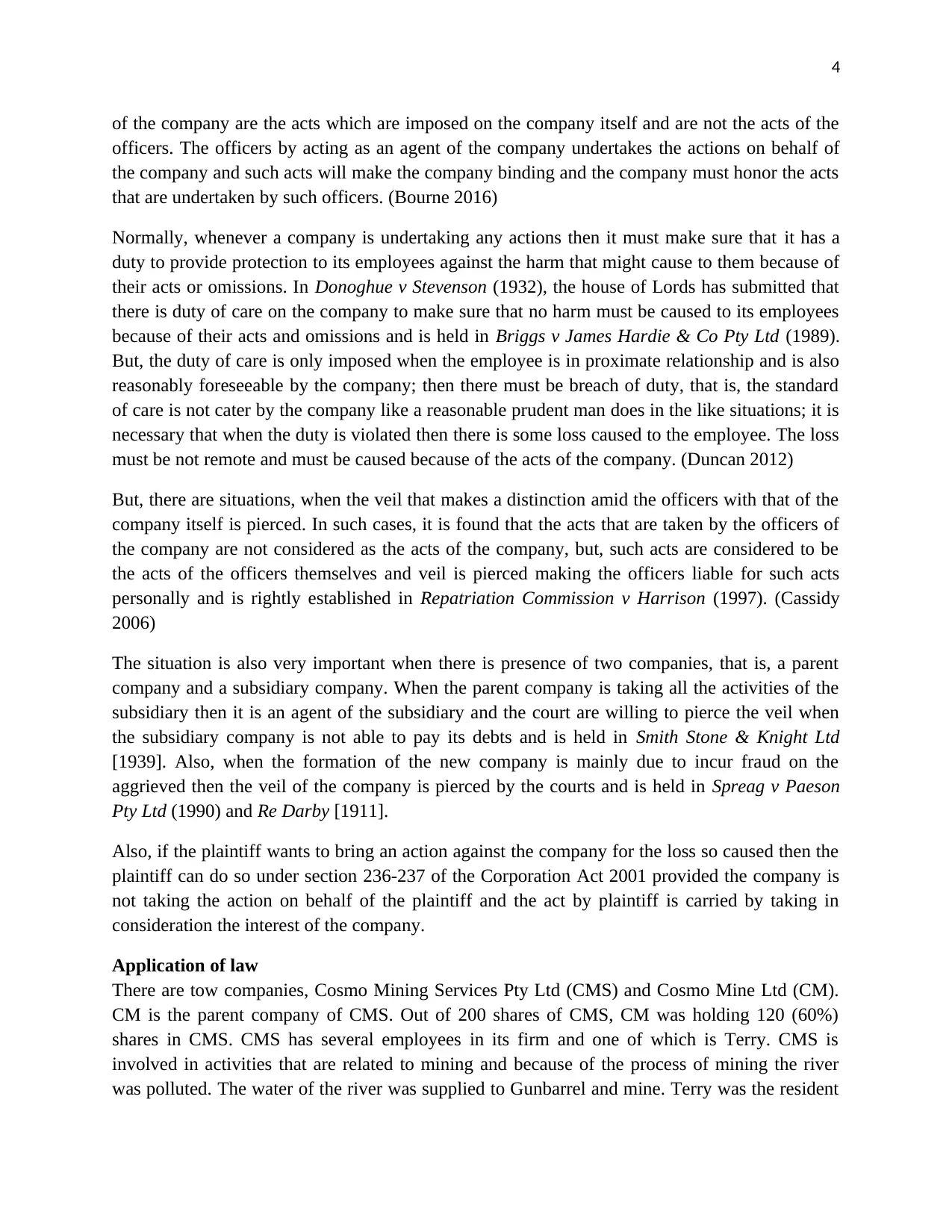
4
of the company are the acts which are imposed on the company itself and are not the acts of the
officers. The officers by acting as an agent of the company undertakes the actions on behalf of
the company and such acts will make the company binding and the company must honor the acts
that are undertaken by such officers. (Bourne 2016)
Normally, whenever a company is undertaking any actions then it must make sure that it has a
duty to provide protection to its employees against the harm that might cause to them because of
their acts or omissions. In Donoghue v Stevenson (1932), the house of Lords has submitted that
there is duty of care on the company to make sure that no harm must be caused to its employees
because of their acts and omissions and is held in Briggs v James Hardie & Co Pty Ltd (1989).
But, the duty of care is only imposed when the employee is in proximate relationship and is also
reasonably foreseeable by the company; then there must be breach of duty, that is, the standard
of care is not cater by the company like a reasonable prudent man does in the like situations; it is
necessary that when the duty is violated then there is some loss caused to the employee. The loss
must be not remote and must be caused because of the acts of the company. (Duncan 2012)
But, there are situations, when the veil that makes a distinction amid the officers with that of the
company itself is pierced. In such cases, it is found that the acts that are taken by the officers of
the company are not considered as the acts of the company, but, such acts are considered to be
the acts of the officers themselves and veil is pierced making the officers liable for such acts
personally and is rightly established in Repatriation Commission v Harrison (1997). (Cassidy
2006)
The situation is also very important when there is presence of two companies, that is, a parent
company and a subsidiary company. When the parent company is taking all the activities of the
subsidiary then it is an agent of the subsidiary and the court are willing to pierce the veil when
the subsidiary company is not able to pay its debts and is held in Smith Stone & Knight Ltd
[1939]. Also, when the formation of the new company is mainly due to incur fraud on the
aggrieved then the veil of the company is pierced by the courts and is held in Spreag v Paeson
Pty Ltd (1990) and Re Darby [1911].
Also, if the plaintiff wants to bring an action against the company for the loss so caused then the
plaintiff can do so under section 236-237 of the Corporation Act 2001 provided the company is
not taking the action on behalf of the plaintiff and the act by plaintiff is carried by taking in
consideration the interest of the company.
Application of law
There are tow companies, Cosmo Mining Services Pty Ltd (CMS) and Cosmo Mine Ltd (CM).
CM is the parent company of CMS. Out of 200 shares of CMS, CM was holding 120 (60%)
shares in CMS. CMS has several employees in its firm and one of which is Terry. CMS is
involved in activities that are related to mining and because of the process of mining the river
was polluted. The water of the river was supplied to Gunbarrel and mine. Terry was the resident
of the company are the acts which are imposed on the company itself and are not the acts of the
officers. The officers by acting as an agent of the company undertakes the actions on behalf of
the company and such acts will make the company binding and the company must honor the acts
that are undertaken by such officers. (Bourne 2016)
Normally, whenever a company is undertaking any actions then it must make sure that it has a
duty to provide protection to its employees against the harm that might cause to them because of
their acts or omissions. In Donoghue v Stevenson (1932), the house of Lords has submitted that
there is duty of care on the company to make sure that no harm must be caused to its employees
because of their acts and omissions and is held in Briggs v James Hardie & Co Pty Ltd (1989).
But, the duty of care is only imposed when the employee is in proximate relationship and is also
reasonably foreseeable by the company; then there must be breach of duty, that is, the standard
of care is not cater by the company like a reasonable prudent man does in the like situations; it is
necessary that when the duty is violated then there is some loss caused to the employee. The loss
must be not remote and must be caused because of the acts of the company. (Duncan 2012)
But, there are situations, when the veil that makes a distinction amid the officers with that of the
company itself is pierced. In such cases, it is found that the acts that are taken by the officers of
the company are not considered as the acts of the company, but, such acts are considered to be
the acts of the officers themselves and veil is pierced making the officers liable for such acts
personally and is rightly established in Repatriation Commission v Harrison (1997). (Cassidy
2006)
The situation is also very important when there is presence of two companies, that is, a parent
company and a subsidiary company. When the parent company is taking all the activities of the
subsidiary then it is an agent of the subsidiary and the court are willing to pierce the veil when
the subsidiary company is not able to pay its debts and is held in Smith Stone & Knight Ltd
[1939]. Also, when the formation of the new company is mainly due to incur fraud on the
aggrieved then the veil of the company is pierced by the courts and is held in Spreag v Paeson
Pty Ltd (1990) and Re Darby [1911].
Also, if the plaintiff wants to bring an action against the company for the loss so caused then the
plaintiff can do so under section 236-237 of the Corporation Act 2001 provided the company is
not taking the action on behalf of the plaintiff and the act by plaintiff is carried by taking in
consideration the interest of the company.
Application of law
There are tow companies, Cosmo Mining Services Pty Ltd (CMS) and Cosmo Mine Ltd (CM).
CM is the parent company of CMS. Out of 200 shares of CMS, CM was holding 120 (60%)
shares in CMS. CMS has several employees in its firm and one of which is Terry. CMS is
involved in activities that are related to mining and because of the process of mining the river
was polluted. The water of the river was supplied to Gunbarrel and mine. Terry was the resident
Paraphrase This Document
Need a fresh take? Get an instant paraphrase of this document with our AI Paraphraser
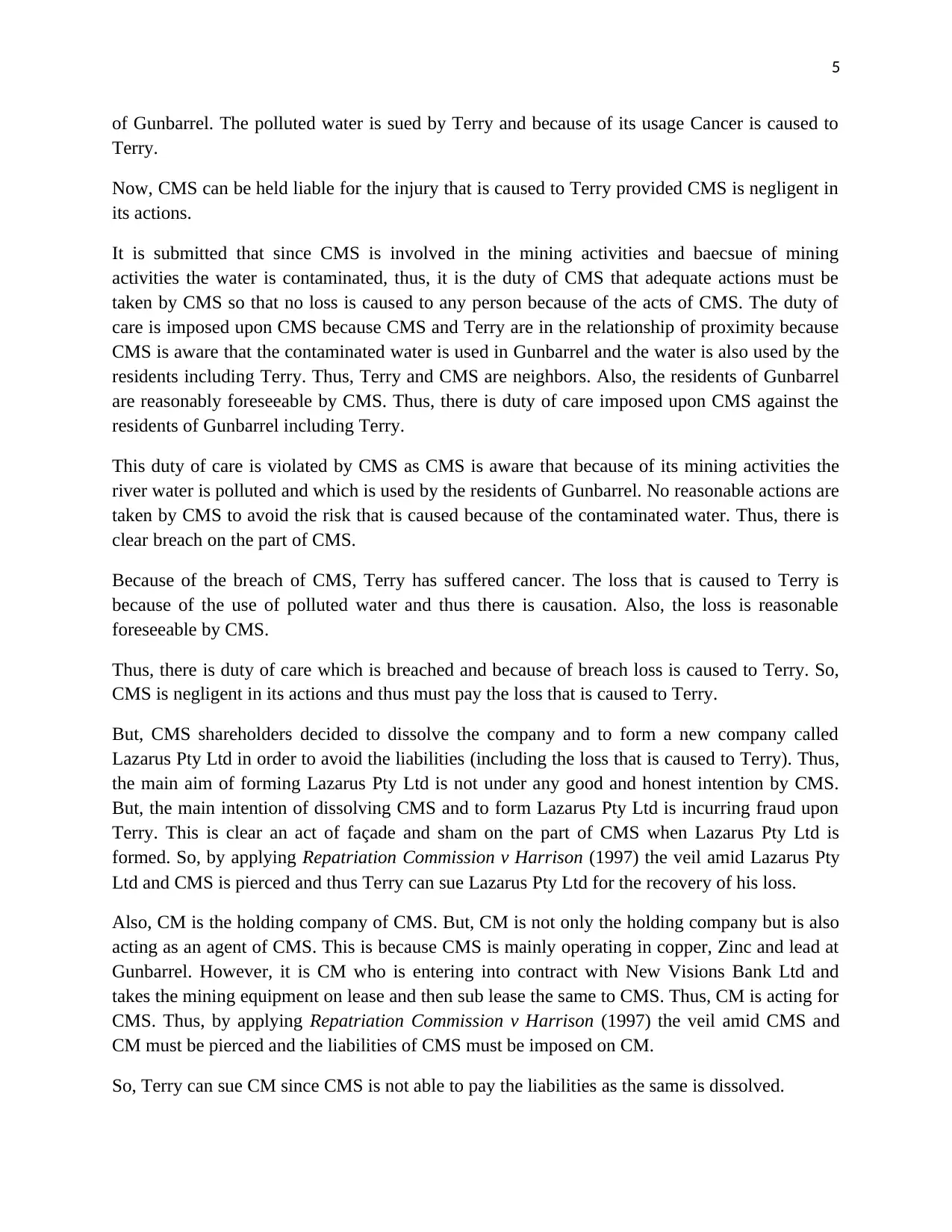
5
of Gunbarrel. The polluted water is sued by Terry and because of its usage Cancer is caused to
Terry.
Now, CMS can be held liable for the injury that is caused to Terry provided CMS is negligent in
its actions.
It is submitted that since CMS is involved in the mining activities and baecsue of mining
activities the water is contaminated, thus, it is the duty of CMS that adequate actions must be
taken by CMS so that no loss is caused to any person because of the acts of CMS. The duty of
care is imposed upon CMS because CMS and Terry are in the relationship of proximity because
CMS is aware that the contaminated water is used in Gunbarrel and the water is also used by the
residents including Terry. Thus, Terry and CMS are neighbors. Also, the residents of Gunbarrel
are reasonably foreseeable by CMS. Thus, there is duty of care imposed upon CMS against the
residents of Gunbarrel including Terry.
This duty of care is violated by CMS as CMS is aware that because of its mining activities the
river water is polluted and which is used by the residents of Gunbarrel. No reasonable actions are
taken by CMS to avoid the risk that is caused because of the contaminated water. Thus, there is
clear breach on the part of CMS.
Because of the breach of CMS, Terry has suffered cancer. The loss that is caused to Terry is
because of the use of polluted water and thus there is causation. Also, the loss is reasonable
foreseeable by CMS.
Thus, there is duty of care which is breached and because of breach loss is caused to Terry. So,
CMS is negligent in its actions and thus must pay the loss that is caused to Terry.
But, CMS shareholders decided to dissolve the company and to form a new company called
Lazarus Pty Ltd in order to avoid the liabilities (including the loss that is caused to Terry). Thus,
the main aim of forming Lazarus Pty Ltd is not under any good and honest intention by CMS.
But, the main intention of dissolving CMS and to form Lazarus Pty Ltd is incurring fraud upon
Terry. This is clear an act of façade and sham on the part of CMS when Lazarus Pty Ltd is
formed. So, by applying Repatriation Commission v Harrison (1997) the veil amid Lazarus Pty
Ltd and CMS is pierced and thus Terry can sue Lazarus Pty Ltd for the recovery of his loss.
Also, CM is the holding company of CMS. But, CM is not only the holding company but is also
acting as an agent of CMS. This is because CMS is mainly operating in copper, Zinc and lead at
Gunbarrel. However, it is CM who is entering into contract with New Visions Bank Ltd and
takes the mining equipment on lease and then sub lease the same to CMS. Thus, CM is acting for
CMS. Thus, by applying Repatriation Commission v Harrison (1997) the veil amid CMS and
CM must be pierced and the liabilities of CMS must be imposed on CM.
So, Terry can sue CM since CMS is not able to pay the liabilities as the same is dissolved.
of Gunbarrel. The polluted water is sued by Terry and because of its usage Cancer is caused to
Terry.
Now, CMS can be held liable for the injury that is caused to Terry provided CMS is negligent in
its actions.
It is submitted that since CMS is involved in the mining activities and baecsue of mining
activities the water is contaminated, thus, it is the duty of CMS that adequate actions must be
taken by CMS so that no loss is caused to any person because of the acts of CMS. The duty of
care is imposed upon CMS because CMS and Terry are in the relationship of proximity because
CMS is aware that the contaminated water is used in Gunbarrel and the water is also used by the
residents including Terry. Thus, Terry and CMS are neighbors. Also, the residents of Gunbarrel
are reasonably foreseeable by CMS. Thus, there is duty of care imposed upon CMS against the
residents of Gunbarrel including Terry.
This duty of care is violated by CMS as CMS is aware that because of its mining activities the
river water is polluted and which is used by the residents of Gunbarrel. No reasonable actions are
taken by CMS to avoid the risk that is caused because of the contaminated water. Thus, there is
clear breach on the part of CMS.
Because of the breach of CMS, Terry has suffered cancer. The loss that is caused to Terry is
because of the use of polluted water and thus there is causation. Also, the loss is reasonable
foreseeable by CMS.
Thus, there is duty of care which is breached and because of breach loss is caused to Terry. So,
CMS is negligent in its actions and thus must pay the loss that is caused to Terry.
But, CMS shareholders decided to dissolve the company and to form a new company called
Lazarus Pty Ltd in order to avoid the liabilities (including the loss that is caused to Terry). Thus,
the main aim of forming Lazarus Pty Ltd is not under any good and honest intention by CMS.
But, the main intention of dissolving CMS and to form Lazarus Pty Ltd is incurring fraud upon
Terry. This is clear an act of façade and sham on the part of CMS when Lazarus Pty Ltd is
formed. So, by applying Repatriation Commission v Harrison (1997) the veil amid Lazarus Pty
Ltd and CMS is pierced and thus Terry can sue Lazarus Pty Ltd for the recovery of his loss.
Also, CM is the holding company of CMS. But, CM is not only the holding company but is also
acting as an agent of CMS. This is because CMS is mainly operating in copper, Zinc and lead at
Gunbarrel. However, it is CM who is entering into contract with New Visions Bank Ltd and
takes the mining equipment on lease and then sub lease the same to CMS. Thus, CM is acting for
CMS. Thus, by applying Repatriation Commission v Harrison (1997) the veil amid CMS and
CM must be pierced and the liabilities of CMS must be imposed on CM.
So, Terry can sue CM since CMS is not able to pay the liabilities as the same is dissolved.
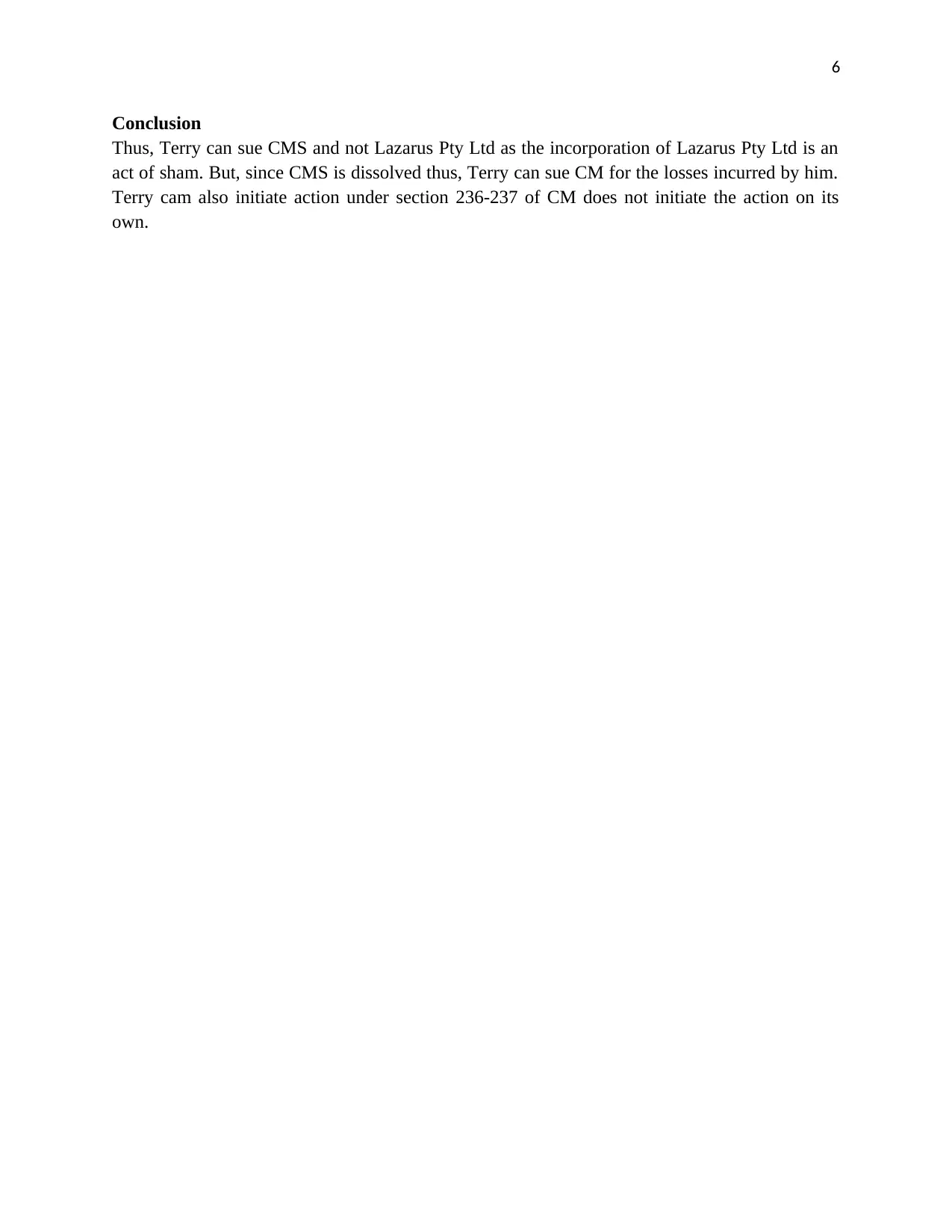
6
Conclusion
Thus, Terry can sue CMS and not Lazarus Pty Ltd as the incorporation of Lazarus Pty Ltd is an
act of sham. But, since CMS is dissolved thus, Terry can sue CM for the losses incurred by him.
Terry cam also initiate action under section 236-237 of CM does not initiate the action on its
own.
Conclusion
Thus, Terry can sue CMS and not Lazarus Pty Ltd as the incorporation of Lazarus Pty Ltd is an
act of sham. But, since CMS is dissolved thus, Terry can sue CM for the losses incurred by him.
Terry cam also initiate action under section 236-237 of CM does not initiate the action on its
own.
⊘ This is a preview!⊘
Do you want full access?
Subscribe today to unlock all pages.

Trusted by 1+ million students worldwide
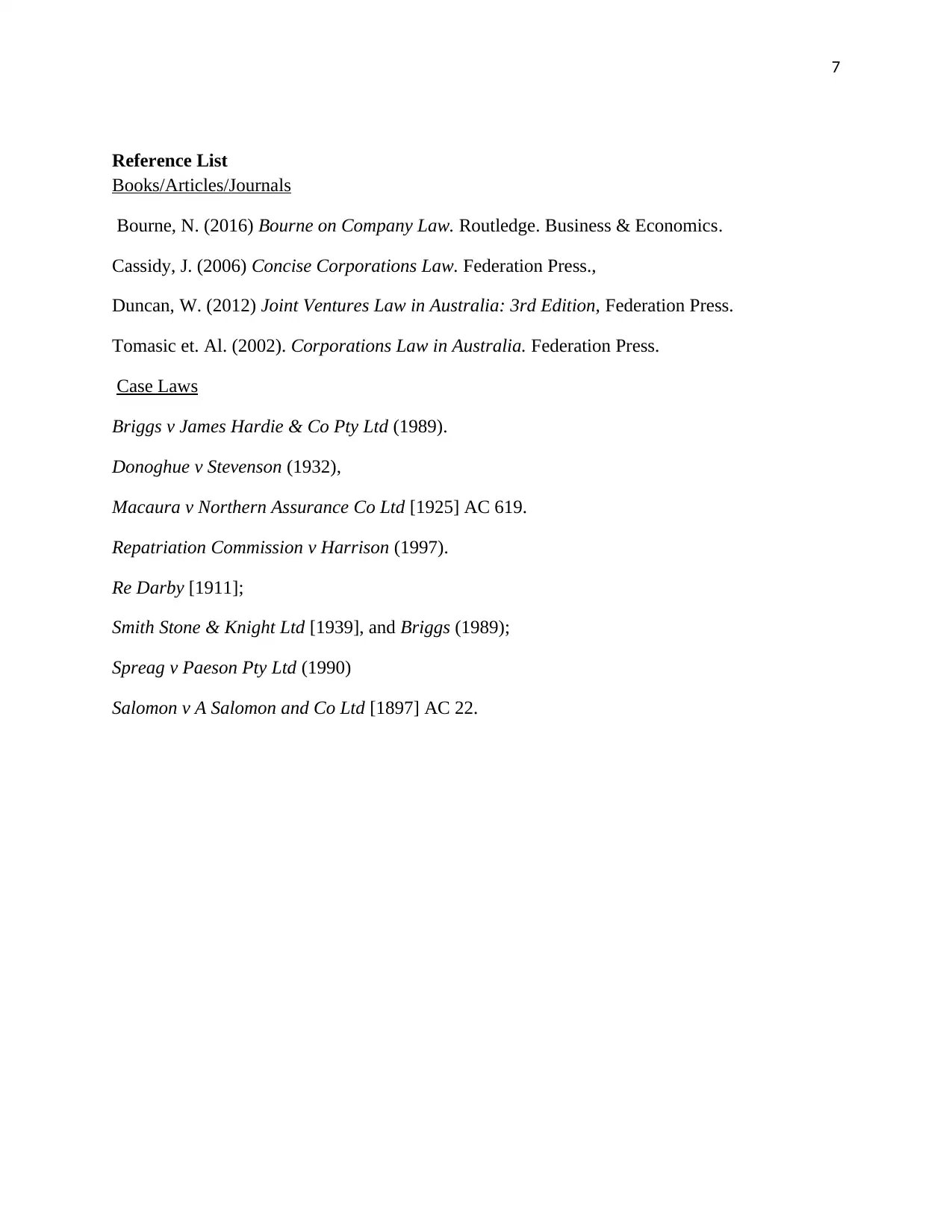
7
Reference List
Books/Articles/Journals
Bourne, N. (2016) Bourne on Company Law. Routledge. Business & Economics.
Cassidy, J. (2006) Concise Corporations Law. Federation Press.,
Duncan, W. (2012) Joint Ventures Law in Australia: 3rd Edition, Federation Press.
Tomasic et. Al. (2002). Corporations Law in Australia. Federation Press.
Case Laws
Briggs v James Hardie & Co Pty Ltd (1989).
Donoghue v Stevenson (1932),
Macaura v Northern Assurance Co Ltd [1925] AC 619.
Repatriation Commission v Harrison (1997).
Re Darby [1911];
Smith Stone & Knight Ltd [1939], and Briggs (1989);
Spreag v Paeson Pty Ltd (1990)
Salomon v A Salomon and Co Ltd [1897] AC 22.
Reference List
Books/Articles/Journals
Bourne, N. (2016) Bourne on Company Law. Routledge. Business & Economics.
Cassidy, J. (2006) Concise Corporations Law. Federation Press.,
Duncan, W. (2012) Joint Ventures Law in Australia: 3rd Edition, Federation Press.
Tomasic et. Al. (2002). Corporations Law in Australia. Federation Press.
Case Laws
Briggs v James Hardie & Co Pty Ltd (1989).
Donoghue v Stevenson (1932),
Macaura v Northern Assurance Co Ltd [1925] AC 619.
Repatriation Commission v Harrison (1997).
Re Darby [1911];
Smith Stone & Knight Ltd [1939], and Briggs (1989);
Spreag v Paeson Pty Ltd (1990)
Salomon v A Salomon and Co Ltd [1897] AC 22.
1 out of 7
Related Documents
Your All-in-One AI-Powered Toolkit for Academic Success.
+13062052269
info@desklib.com
Available 24*7 on WhatsApp / Email
![[object Object]](/_next/static/media/star-bottom.7253800d.svg)
Unlock your academic potential
Copyright © 2020–2025 A2Z Services. All Rights Reserved. Developed and managed by ZUCOL.





